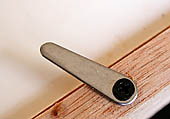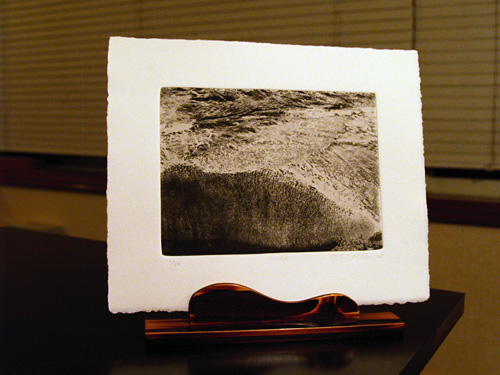
Framing Tips

Photogravure etchings are among the most permanent works of art in existence. The pigment in black etching ink is finely ground carbon particles: it never fades. Etching paper is made from cotton fiber, washi from kozo or mulberry fiber, neither of which contain the lingin from wood pulp that causes deterioration of ordinary paper.
This Japanese-style stand (shown below) encloses the print (Swirl)between two curved bamboo shapes, making a distinctive accent for any surface.
 Small prints invite close viewing, revealing details of form, color, texture, and depth that can only be seen close-up.
Small prints invite close viewing, revealing details of form, color, texture, and depth that can only be seen close-up.
Prints can be conserved safely in archival storage boxes, separated by interleaving sheets. It's better for them to be stored this way than in frames when not on view, and it saves space. Archival (acid-free, neutral-pH or buffered) storage boxes are available from the following suppliers:
Conservation Resources (UK) Ltd: https://www.conservationresources.com/
Preservation Equipment: www.preservationequipment.com/
Throughout the more than five centuries of printmaking, people have cherished original prints for their hand-made qualities of tactile immediacy, range of tone or color, depth, and uniqueness of imprint. Each printmaking medium has a distinctive look, a visual 'language' of its own -- the flowing line of engraving, the incisive etched line, the watercolor-like shading of aquatint, the tonal subtlety and depth of photogravure, the autographic look of lithographs, the flattened planes or bold outlines of woodcuts, and many more. The variety is endless, and new methods and materials continually add to it.
Over time, printmaking techniques cycle between the rare and precious on one hand, and the widespread and readily available on the other. A novel technique is developed, skill is nurtured through long years of practice, and passed down through personal instruction. The technique in time becomes mannered, subject to imitation, and accessible to unskilled copyists. Eventually publication-type prints compete in the market with rare original prints, displacing them except among connoisseurs. While connoisseurs value individual style of execution and the tactile and graphic qualities of prints, popular demand responds more to information content and price, though it is by no means indifferent to style. Yesterday's publication-type prints can become today's rare prints, as with Japanese woodcuts and some European lithographs and posters.
Original photogravure etchings are made by hand, one impression at a time, from a copperplate etched by the artist. Each pass of the copperplate through the etching press wears down the plate, which is why limited editions have natural rarity. Differences within the edition result partly from plate wear, but more important than the minor distinctions between earlier and later numbers of the edition are the dramatic interpretive variations that can occur with different ways of removing ink from the copperplate. For those who prefer a mass-produced appearance, the rigid uniformity of posters and digital prints is adequate. For those who prefer the distinctive tactile quality of a hand-made print, variations within the edition enable a more discriminating choice. Knowledge of printmaking techniques enables collectors to distinguish original artist-made prints from reproductions. Apart from the need to verify authenticity, appreciating the unique 'visual language' of each medium enhances the pleasure of making it part of your visual environment.
Chuang-tzu and Hui-tzu were walking on the Hao River bridge. Chuang-tzu said: 'Those mottled fish have come out to roam as they please; that is happiness for fish.'Hui-tzu replied: 'You are not a fish; how do you know what is happiness for fish?' Chuang-tzu said: 'You are not me; how do you know that I don't know what is happiness for fish? Hui-tzu replied: I am not you, and assuredly have not full comprehension of you, but you certainly are not a fish and that you do not know what is happiness for fish is equally certain!' Chuang-tzu said: 'Please keep to the point. When you said how do you know what is happiness for fish' you already understood that I did know it. But, since you ask me, I knew it from being above the Hao River and watching them. (from Parables of Si-Tien, by Adam Podgórecki (London: Poets' and Painters' Press, 1972).
For suggestions on how to look at prints, see How to Look at Prints. Stanley William Hayter, the founder of Atelier 17 in Paris, discloses his method of excluding all extraneous influence to focus on the print itself. Former New York Metropolitan Museum Director Thomas Hoving uses research and first impressions to validate each other. Henri Focillon reveals how The Life of Forms 'translates into space certain movements of the mind'.
Site: Home・ホーム; Viewing・見聞; Learning・情報; Purchasing・ご注文; News ・ ニユース; Videos・ビデオ Xpress
Series: Temples・寺; Dreamscapes・夢; Seascapes・海; Furusato・ふるさと; Pathways・道; Mongolia・モンゴル; Acts & Scenes・町; Unseen・見残す; New Prints・新
Original photogravure etchings may be purchased through this website by clicking the order button on any full-screen image page, or from these fine print dealers:
Baltimore: Conrad R Graeber Fine Art, Box 264, Riderwood, Md, U.S.A., tel +1-410-377-6713
San Francisco: Japonesque, 824 Montgomery Street, SF, Ca, U.S.A., tel +1-415 391-8860
Netherlands: Eric van den Ing, Saru Gallery, tel: +31(0)6-2246-4074.
Vladivostok: Arka Gallery, 5 Svetlanskaya St, Vladivostok, Russia, tel +7-4232-410-526
See for yourself!
Contact ・ 連絡: Please type  into your email (日本語 OK).
into your email (日本語 OK).